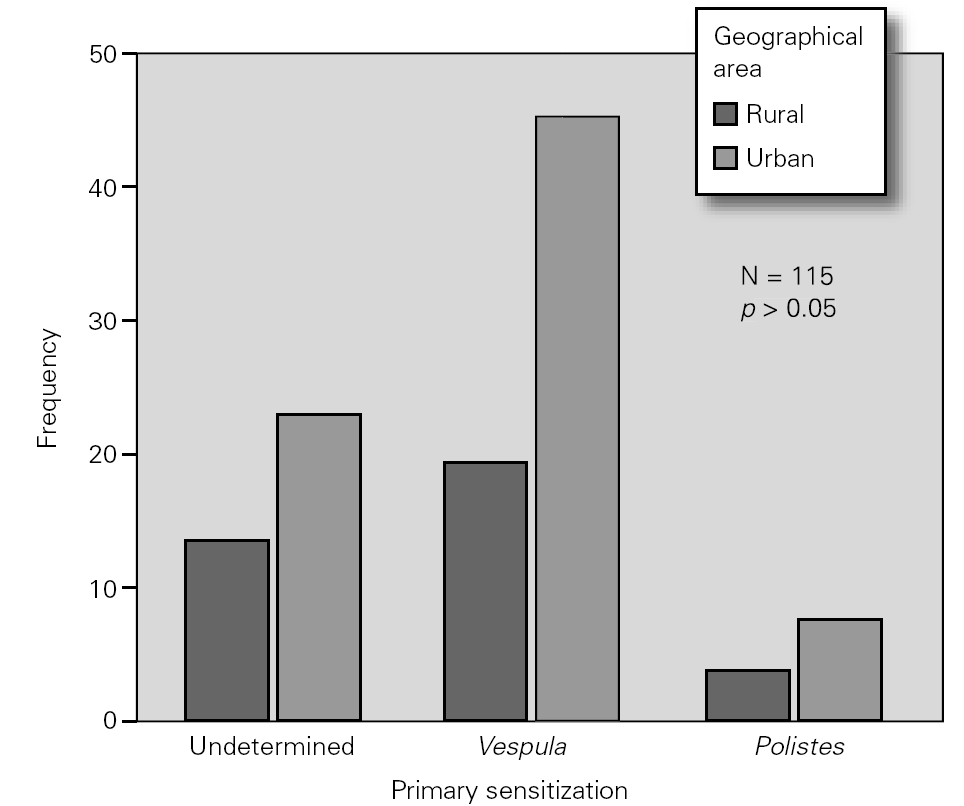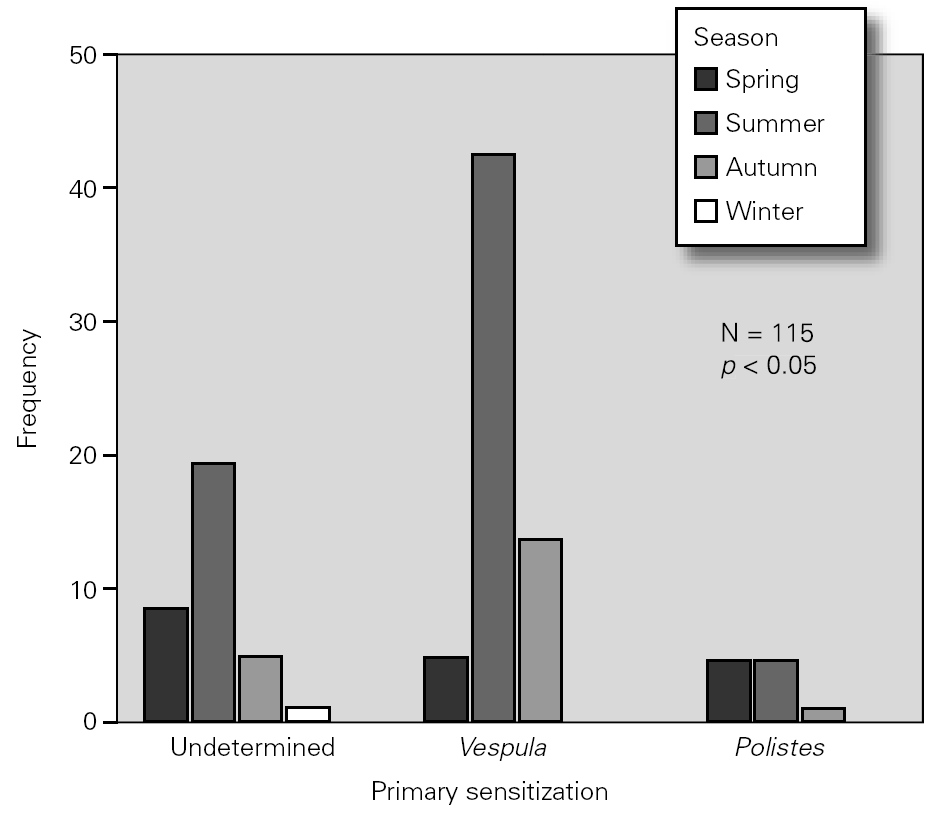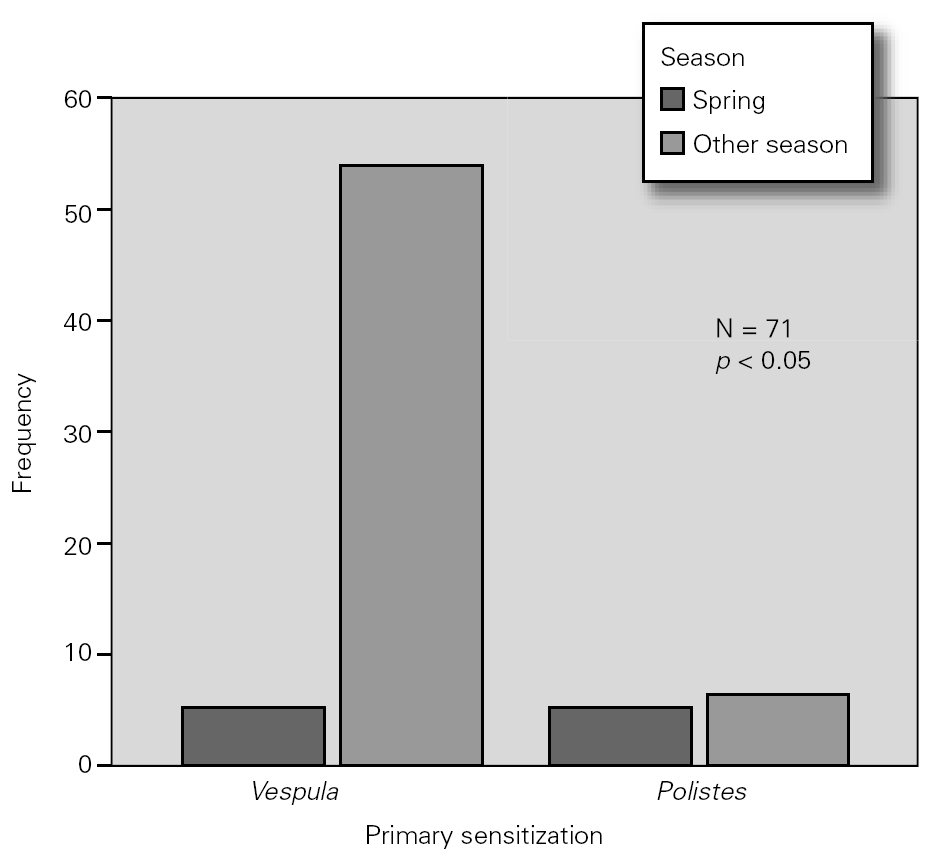INTRODUCTION
IgE-mediated hypersensitivity to both Vespula and Polistes species is frequently observed in patients who present with a systemic reaction to wasp sting1-6. This double sensitization has important implications for proper venom immunotherapy. Most in vitro studies suggest a possible cross-reactivity between venoms from common wasp (Vespula) and paper wasp (Polistes), but the primary sensitization and the clinical significance are not clear enough2-11. We therefore examined the geographical and seasonal circumstances of the sting to know their relationship with the results of serum specific IgE to vespid venoms.
MATERIAL AND METHODS
A retrospective study was performed on 115 patients (10-80 years of age) presenting to the Allergy Department of the Puerta de Hierro University Hospital (Madrid), between January 1, 1994 and December 31, 2005. All patients suffered an immediate systemic reaction to wasp sting, and showed serum specific IgE to venoms from Vespula and/or Polistes, which was measured using the Pharmacia CAP System method (Uppsala, Sweden). The patients were resident in the north-western area of the Community of Madrid. Every patient was asked about the specific circumstances at the moment of the anaphylaxis-induced sting, which included season (spring, summer, autumn and winter) and type of locality (urban or rural). Results of the specific IgE to wasp venom were obtained from a review of the medical record. Patients were determined as having primary sensitisation to whichever genus of wasp (Vespula and/or Polistes) for which the highest class of specific IgE was observed. When a patient showed the same class of specific IgE to both venoms, an undetermined result was assigned.
The data were recorded and analysed using SPSS for Windows, version 12.0. The relationship between primary sensitization and season, as well as primary sensitization and type of locality, were assessed by the chi-square test. Differences were considered statistically significant at p values of less than 0.05.
RESULTS
The average age was 40.2 years (standard deviation: 15.9), and the male/female ratio was 60/55. The sting that caused the reaction took place in rural areas in 37 cases (32.2 %), whereas urban areas accounted for 78 cases (67.8 %). The distribution of cases according to season resulted in the following: 18 (17.3 %), spring; 66 (63.4 %), summer; 19 (18.3 %), autumn; and 1 (0.9 %), winter. One hundred and nine patients (94.8 %) showed serum specific IgE to Vespula, whereas IgE to Polistes was detected in 90 (77.8 %). The primary sensitization was to Vespula in 65 cases (56.5 %) and Polistes in 12 cases (10.4 %). There were no differences between the levels of specific IgE to both venoms in 38 patients (33 %).
The analysis of the primary sensitization related to geographical area showed that the urban area was more frequent in all groups (Vespula, Polistes, and undetermined sensitization), with no statistically significant differences (p > 0.05) (fig. 1). The frequency of sensitization related to season showed a higher number of patients with primary sensitization to Vespula among the cases occurring in summer and autumn (fig. 2). To analyze properly this difference, the patients with undetermined sensitization were deleted and the variable season was categorized into two values: spring and other season. Thus, we obtained a distribution of 71 cases with a statistically significant higher frequency of patients with primary sensitization to Vespula who suffered the reaction after the spring, in contrast with the patients who were primarily sensitized to Polistes (p < 0.05) (fig. 3).
Figure 1.--Clustered bar charts for geographical area and primary sensitization.
Figure 2.--Clustered bar charts for season and primary sensitization.
Figure 3.--Clustered bar charts for season (given as "spring" and "other season") and primary sensitization (excluding cases with undetermined sensitization).
DISCUSSION
Our study population shows a higher frequency of hypersensitivity to Vespula venom, in contrast with studies in the Mediterranean area of Spain, where hypersensitivity to Polistes venom is more frequent3,4. Nevertheless, most patients were sensitized to both Vespula and Polistes. This fact may be explained by the presence of cross-reactivity, as it is well recognised in several prior studies3-11.
Most cases of anaphylaxis-induced sting occurred in urban areas, probably because the region in which the study took place is comprised primarily of residential neighbourhoods. The greographical area could not provide information about the primary sensitization. This result suggests that both vespids share the same habitat, with no discrimination between rural and urban areas.
On the other hand, the seasonal distribution of the cases is certainly related to the primary sensitization. We observed that the probability of Vespula sting is higher than Polistes sting when the reaction occurs after spring. This finding is of interest in clinical practice, can help us to identify the responsible vespid when the diagnostic tests do not provide an accurate result, and may be useful for the selection of the right venom for specific immunotherapy.
Correspondence:
A.J. Pérez Pimiento
Servicio de Alergia
Hospital Universitario Puerta de Hierro
San Martín de Porres, 4. 28035 Madrid. Spain
Tel. (0034) 913445844
Fax.(0034) 913730535
E-mail: aperezpimiento@yahoo.es










